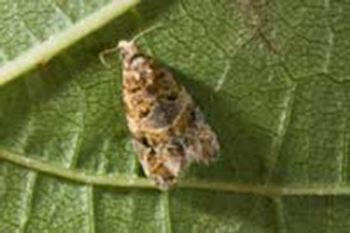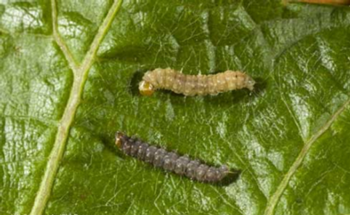Summer 2012: Regulatory Updates
Regional Report San Benito and Santa Clara Counties by Maria de la Fuente
European Grapevine Moth Update (EGVM)
EGVM was first detected in the United States in the Napa Valley in October 2009. The pest (Lobesia botrana) is found in Southern Europe, North Africa, Anatolia, the Caucasus and Chile where it causes serious damage in grapes. Trapping and quarantines have therefore been established in a number of counties in California. Although the literature indicates that some ornamentals may be hosts, so far only flowers of olive trees adjacent to vineyards have been found to be infested by EGVM in California. However, it still is feared that ornamentals may harbor the pest and move it with shipments on infested hosts even if EGVM may not be a particularly damaging pest on ornamentals. Since it is not clear how important nursery hosts are to the movement of EGVM, for now regulatory authorities are emphasizing the control of the most obvious path of movement — on grape plants and fruit. Nursery growers that produce fruit trees, grapes and other known hosts of EGVM should be monitoring for this pest.
 |
 |
Adult female European grapevine moth (EGVM) Lobesia botrana (left) and larvae (right). Earlier stages of EGVM larvae are tan to yellow-brown (top). Later stages become dark colored (bottom). Photos by J. K. Clark, Courtesy of UC IPM
The EGVM Technical Working Group (TWG) convened in Sacramento to meet and discuss the year’s program activities and to make recommendations for the program’s continued progress in 2012. The TWG is composed of scientists from around the world who have experience with controlling EGVM in their home countries; their role is to make recommendations to the California Department of Food and Agriculture (CDFA) and the United States Department of Agriculture - Animal and Plant Health Inspection Service (USDA-APHIS) on how to best go about the eradication efforts here in California.
The TWG’s recommendations have been reviewed by the USDA and CDFA and those that were adopted include lifting the quarantine regulation from the counties of Fresno, Mendocino, Merced and San Joaquin effective March 8, 2012 and reducing the quarantine areas throughout the State from 5 miles surrounding detections to 3 miles from detections. Rubus spp. (blackberries, raspberries) have been removed from the EGVM host list.
The counties of Santa Clara, Santa Cruz and Nevada will be deregulated after the 2012 season if: (1) No further EGVM detections are made; (2) EGVM trapping is conducted at 25 traps per square mile throughout the 2012 season; (3) EGVM trapping within 500 meters of detections made in 2010 and 2011 is conducted at 100 traps per square mile for at least two generations prior to deregulation; (4) Treatment for EGVM control are made during the first and second generations of 2012 (May/June and July/August) in all vineyards within 500 meters of detections; (5) No mating disruption is used during 2012.
The Santa Clara County EGVM detection program has deployed traps in vineyards throughout the county as well as within the three-mile quarantine area. The traps will be serviced every two weeks through mid-October 2012. In 2012, growers will apply treatments to grapes growing within a 500-meter radius from EGVM detections. Non-commercial grape growers within this treatment area will again have the choice of having treatment of Bacillus thuringiensis (Bt) or flowers/fruit removal by CDFA staff. Commercial grape growers within the treatment area will conduct first and second generation EGVM control treatments, just as in 2011. Degree-day modeling will determine when treatments will be made. The University of California created a degree-day website for EGVM infested areas. The site has not been updated for the 2012 season, but can be viewed and bookmarked for future use at the UC Cooperative Extension Sonoma county’s web site http://cesonoma.ucdavis.edu/files/84650.pdf.
The Santa Clara County quarantine boundaries have been substantially reduced in 2012, freeing several growers from commodity shipping restrictions. These growers are being contacted by their District Biologist and informed of the modified restrictions.
For additional information on EGVM, view the University of California’s IPM guideline at: http://www.ipm.ucdavis.edu/EXOTIC/eurograpevinemoth.html. An article on the potential impact of this pest for nursery growers was published in Steve Tjosvold’s Regional Report for the winter 2011 edition of UCNFA News: http://ucanr.org/sites/UCNFAnews/Regional_Report_Santa_Cruz_Monterey_Cos/.
Maps of the quarantine and related information may be found online at: http://www.cdfa.ca.gov/phpps/PE/InteriorExclusion/egvm_quarantine.html http://www.aphis.usda.gov/plant_health/plant_pest_info/eg_moth/index.shtml
Methyl Bromide Alternatives and Fumigation Regulations Update
Methyl iodide update. In March, Arysta LifeScience Corporation announced the immediate suspension of product sales for all formulations of the fumigant MIDAS® in the United States. Methyl iodide (iodomethane) had been considered as a potential replacement for methyl bromide, whose use is being phased-out due to its ozone-depleting properties.
The decision to suspend sales was made as part of an internal review of the fumigant and based on its economic viability in the U.S. marketplace. Arysta LifeScience will continue to support the use of iodomethane outside of the United States where it remains economically viable.
Metam sodium and metam potassium buffer zone mitigation measures. The pre-plant soil fumigants, metam sodium and metam potassium are important tools for successful and viable production of nursery crops in Santa Clara County. The application of these materials in California can be accomplished through a variety of methods – shank injection, spray blade, rotary tiller, sprinkler, drench and drip. In Santa Clara County, all applications are now made through drip lines buried within prepared beds.
The County of Santa Clara – Division of Agriculture has been working with the Department of Pesticide Regulation in a review of scientific studies to determine whether mitigation measures could be developed for Santa Clara County to lessen the buffer zone requirements for drip applications of the methyl isothiocyanate (MITC)-generating fumigants. The mitigations were developed with input from end-users to ensure the measures incorporated viable field practices.
The mitigation measures require that drip tape must be buried under at least 6 inches of soil and that water must be run through the drip lines for 1 to 2 hours immediately following the completion of the application. A second post-application of water must be applied through the drip lines or sprinklers the evening of the application, beginning one hour before sunset and running from 1 to 3 hours. Each post-application water treatment must apply a total of 0.2 to 0.4 acre inches of water. These mitigation measures have been finalized for use in Santa Clara County, and are now being included as part of the conditions of use for metam sodium and metam potassium restricted material permits.
Pesticide Illness Surveillance Program
Agricultural commissioners investigate pesticide illnesses that occur in their jurisdictions, whether or not they involve agriculture. The investigators attempt to locate and interview all people with knowledge of the exposure events, collect samples when useful, and review relevant records. When appropriate, they request authorization from the affected people to obtain relevant portions of their medical records to include with the investigative reports.
The Department of Pesticide Regulation (DPR) provides instructions, training and technical support for the investigators. The instructions include directions for when and how to collect samples of foliage, clothing, or surface residues to document unintended exposure or contamination of persons and/or the environment. As part of the technical support, DPR contracts with a California Department of Food and Agriculture Center of Analytical Chemistry (CAC) to analyze the samples.
When investigations are complete, CAC send reports to DPR describing their findings. These reports describe the circumstances that may have led to pesticide exposure and the consequences to the exposed individuals. In their role as enforcement agents, CAC also determine whether pesticide users complied with safety requirements. In 2009, there were 1,329 reported cases of pesticide exposure. Of those cases, 308 were related to agricultural use. In Santa Clara County, there were 44 reported pesticide illness or injury incidents, with two of those cases related to the agricultural use of pesticides. The compilation of reports and statistics on pesticide illness investigations in California for 2009 is available for viewing at http://www.cdpr.ca.gov/docs/whs/2009pisp.htm.
Annual Well Inventory
A report summarizing well sampling results collected by DPR and the California Department of Public Health in 2011 was released in February. It includes an analysis of the results to determine probable sources of detected pesticides and actions taken to prevent migration of pesticides to ground water. In Santa Clara County, more that 1500 well samples were tested for 44 different pesticides. No pesticides were detected in these samples. The report can be viewed at www.cdpr.ca.gov/docs/emon/grndwtr/wellinv/wirmain.htm
Phytosanitary Certificate and Issuance Tracking System
On March 1, 2012, the County of Santa Clara – Division of Agriculture adopted the Phytosanitary Certificate and Issuance Tracking (PCIT) software system to electronically generate and process export certificates for local shippers. The system was created by the USDA-APHIS and has been in use in locations across the country since 2005.
Originally, PCIT was developed to issue Federal phytosanitary export certificates. It can now also be used to issue State phytosanitary certificates and has been modified to allow local governments to collect certification fees electronically. PCIT offers many timesaving functions to our shippers and also reduces the cost of each certificate issued by $6.00. APHIS is making several improvements to PCIT in the coming months. PCIT will begin automatically transferring phytosanitary certificates to foreign countries receiving U.S. exports, reducing previous delays associated with paperwork verification. In addition, APHIS is expanding the availability of user-printed phytosanitary certificates, eliminating the need for users to pay for shipped documents.
María de la Fuente
County Director / Farm and Master Gardener Advisor
UC Cooperative Extension San Benito, Santa Clara, and Monterey Counties
649 San Benito Street, Ste 115
Hollister, CA 95024
phone (831)637-5346 X 13 (SB), (408)282-3131 (SC), (831) 759-7358 (M)
medelafuente@ucanr.edu












